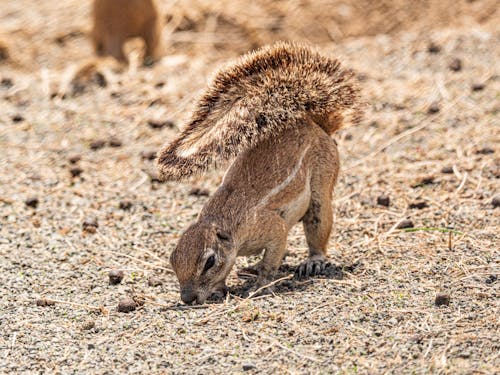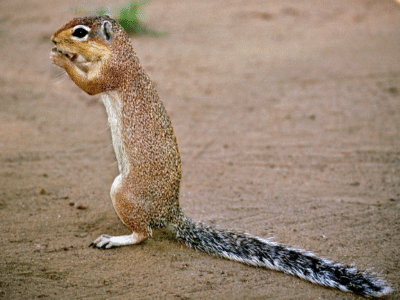Xerus are ground squirrels from Africa, living mostly in dry grasslands, savannas, and rocky places. They dig burrows, run around during the day, and eat seeds, roots, insects, and sometimes eggs. Their tails are bushy and used for shade or signaling.
 Image showing a Xerus with tail arched above its back (Source: Dreamstime)
Image showing a Xerus with tail arched above its back (Source: Dreamstime)
Scientific classification
- kingdom: Animalia
- phylum: Chordata
- class: Mammalia
- order: Rodentia
- family: Sciuridae
- genus: Xerus
Physical characteristics
- They have coarse short fur, color ranging from light brown to reddish or gray, depending on the species and habitat.
- They have strong claws for digging.
- Their tails are long, often flattened and bushy, used like a parasol to block sunlight.
- Eyebrows or white stripes may mark some species.
- Males among them are generally slightly larger than females.
 Image showing a close-up of a Xerus using its tail to shield itself from the sun (Source: iStock).
Image showing a close-up of a Xerus using its tail to shield itself from the sun (Source: iStock).
Habitat and distribution
- Xerus live in sub-Saharan Africa: savannas, dry shrublands, grasslands, even deserts.
- They avoid dense forests or swamps.
- Their range stretches from southern Africa to eastern and northern dry lands.
- Burrows provide shelter and protection.
Diet and feeding habits
- They eat mostly plants: seeds, bulbs, roots, grasses.
- When insects or small animals are available, they add them in.
- Some species cache food (store seeds) around burrow entrances, though many eat what they find.
- Water comes usually from the food, so they don’t need to drink often.
Life cycle and reproduction
- Females bear litters of pups (usually 1 to 3 young).
- Gestation lasts about 48 days in species like Xerus inauris.
- Young are born hairless, blind, depend on mothers until they open eyes and leave burrow.
- Adults reach sexual maturity several months after birth.
Behavior and adaptations
- They live in burrows which help them hide from predators and escape heat.
- During hot times, they retreat to shade or underground.
- Their tails are raised over their backs to cast shade and reduce sun exposure.
- They are social: colonies with many individuals, vocalizing to warn each other of danger.
- They spend much time foraging and sun-bathing.
All known species
Here are a few Xerus species to know:
1. Xerus erythropus (striped ground squirrel): has a conspicuous white stripe down each side; common over much of western and central Africa.
 Image showing a striped ground squirrel sniffing into dry soil (Source: Pexels)
Image showing a striped ground squirrel sniffing into dry soil (Source: Pexels)
2. Xerus inauris (Cape ground squirrel): lives in southern Africa, including the Kalahari; reddish tones, white stripes, social groups.
 Image showing a group of Cape ground squirrels standing upright and scanning for predators (Source: iStock)
Image showing a group of Cape ground squirrels standing upright and scanning for predators (Source: iStock)
3. Xerus princeps (mountain or Damara ground squirrel): found in southwestern Africa; looks similar to the Cape ground squirrel but lives in more rugged terrain; differs in size and color.
Xerus princeps (mountain or Damara ground squirrel) (Source: Barry – Jungle dragon).
4. Xerus rutilus (unstriped ground squirrel): does not have side stripes; lives in arid lands of East Africa.

Image showing Xerus rutilus (unstriped ground squirrel) (Source: Bernard Dupont – iNaturalist)
Threats and conservation status
- Most Xerus species are listed as Least Concern by IUCN.
- They seem to cope with local habitat change. But loss of grasslands, overuse of land, droughts, and human-caused changes could reduce numbers in some places.
Interaction with humans
- People sometimes see Xerus near farms.
- They may eat crops, bulbs, or roots, which makes them pests locally.
- At same time, their burrows helps to aerate soil.
- They are not dangerous.
- Some are photographed for wildlife tours or enjoyed by observers.
Fun facts
- Xerus tail is used like a sunshade: they raise it overhead to block sun.
- Striped ground squirrels sometimes hide cached seeds and forget some; those seeds may grow into new plants.
- Cape ground squirrels have large testicles relative to body size, which relates to competition among males.
You can reach out to us at Doctor Hulk Veterinary Hospital through 08143397614 for questions about wild mammals, animals near you, or conservation.













Reviews
There are no reviews yet.